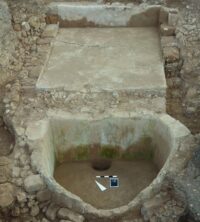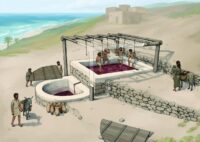 University of Tübingen archaeologists have discovered the first Phoenician wine press at Tell el-Burak in Lebanon. In the first millennium B.C., Phoenician trade was instrumental in the spread of wine around the Mediterranean, but the archaeological evidence from this period has come almost entirely from the consumption side — amphorae used to transport it to buyers, drinking sets, how different vessels were adapted for mixing, sharing and imbibing. Archaeological remains of wine production in Phoenicia itself, however, has never been discovered before.
University of Tübingen archaeologists have discovered the first Phoenician wine press at Tell el-Burak in Lebanon. In the first millennium B.C., Phoenician trade was instrumental in the spread of wine around the Mediterranean, but the archaeological evidence from this period has come almost entirely from the consumption side — amphorae used to transport it to buyers, drinking sets, how different vessels were adapted for mixing, sharing and imbibing. Archaeological remains of wine production in Phoenicia itself, however, has never been discovered before.
The settlement of Tell el-Burak is six miles south of Sidon on the Mediterranean coast. It was founded by Sidon in the last quarter of the 8th century B.C. and was occupied until the middle of the 4th. Recent excavations discovered the remains of four houses dating to the Iron Age. Inside one of them was a courtyard with a plastered basin beneath the floor. This is the treading basin of the wine press. Archaebotanical remains indicate the settlement was agriculturally active, and most of the, 41.7%, consist of grape vine seeds.
 The winemaking installation was constructed during the late 8th century B.C. and was in use into the 6th century B.C. Two other plastered structures in the Iron Age home may also have been connected to the wine production, but archaeologists are uncertain what function they performed. A large number of transport amphorae found in earlier excavations add to the evidence that this was an extensive wine production facility active for centuries.
The winemaking installation was constructed during the late 8th century B.C. and was in use into the 6th century B.C. Two other plastered structures in the Iron Age home may also have been connected to the wine production, but archaeologists are uncertain what function they performed. A large number of transport amphorae found in earlier excavations add to the evidence that this was an extensive wine production facility active for centuries.
The discovery also lends new insight into Phoenician construction methods and materials.
Analyses carried out at the Tübingen CCA-BW within the framework of the ResourceCultures collaborative research center (1070) have now provided new data on the composition and technology of the Iron Age plaster of which the wine press was made. “A good-quality lime plaster could be difficult to produce,” say the authors, “The Phoenicians refined the process by using recycled ceramic shards. This made it possible to build better and at the same time more stable buildings.” A local and innovative tradition of lime plaster had developed in southern Phoenicia, they add, “The finished plaster was water-resistant and hardwearing. The Romans adopted this technique for making their buildings.” An ongoing organic residue analysis at the University of Tübingen may determine whether all three plastered structures at Tell el-Burak were connected to wine production.
The study has been published in the journal Antiquity and can be read here.
“Plastered” etymology-search inconclusive.
There appears to be a drain at the back of the receiving chamber, but I can’t see what it could have drained into.
could have been plugged, then when the wine was drained off the sediment when then flushed away?
Looks more like a sump than a drain. Sumps would catch seeds and other detritus. Even some modern wineries use them.